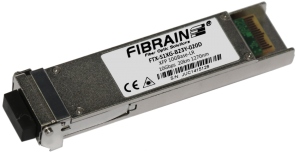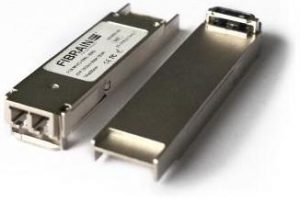Wyświetlanie wszystkich wyników: 3Posortowane według najnowszych
Specyfikacja XFP była rozwijana przez XFP Multi Source Agreement Group. Pierwsza z nich została opublikowana 27 marca 2002r. Została ona przyjęta przez środowisko telekomunikacyjne rok później, 3 marca 2003r. Moduły XFP mogą być „wyjmowane na gorąco” a także są niezależne od protokołów w transmisji. Wykorzystują one złącze optyczne LC do osiągnięcia większej gęstości portów. Moduły XFP pracują na falach: 850nm, 1310 nm or 1550 nm. Maksymalna przepustowość wkładek XFP to 11.3Gbps, natomiast główne wspierane aplikacje to 10Gigabit Ethernet, 10Gb/s Fibre Channel, SONET (OC-192), SDH @ STM-64, 10Gb/s Optical Transport Network (OTN) OTU-2. XFP może pracować również na pojedynczym włóknie światłowodowym czy też wykorzystywać technologię WDM do transmisji danych. Wspierają również cyfrową diagnostykę która została dodana w standardzie SFF-8472.
Wkładki XFP są uznawane za następcę optycznych modułów XENPAK i X2. Niewielkie rozmiary oraz niższy pobór mocy uczynił z optycznych wkładek XFP świetne wyposażenie dla aplikacji wymagających dużej gęstości portów np. wysokiej pojemności routerów czy też przełączników. W zależności od typu transmitera czy też odbiornika używanego w poszczególnych modelach mogą one transmitować na odległość do 80km (bez dodatkowych zewnętrznych optycznych wzmacniaczy). Niektóre moduły są dostępne z wbudowanym elektroniczną kompensacją dyspersji monochromatycznej – w tym przypadku wkładki XFP mogą osiągać do 120km. Moduły mogą zostać zaprogramowane jako kompatybilne z: Cisco, HP, Netgear, Avaya, D-Link, Brocade, Extreme Networks, Huawei, Enterasys, 3Com, Alcatel-Lucent i innymi. Aby potwierdzić kompatybilność wkładek, prosimy o kontakt z działem wsparcia technicznego przed zamówieniem.


